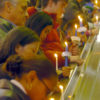Critiquing Hate Crimes Legislation

In this lesson, students learn to access, study and compare primary-source documents, to research and organize information and to plan, organize and execute a live performance.

Instructional Resources for California Educators, Students, & Families

In this lesson, students learn to access, study and compare primary-source documents, to research and organize information and to plan, organize and execute a live performance.

In this lesson students listen to the oral history of an advocate for LGBT family rights, and use her personal story as a vehicle for considering how anti-LGBT attitudes are formed. Students explore the derivation of the words “gay,” “f*ggot” and “d*ke” in order to better understand the long history of judgment and hate behind these words. They also reflect on the testimony of LGBT teens about the impact of terms like “that’s so gay.”

In this lesson, students research and create a timeline that illustrates how attitudes toward gay and lesbian issues have changed over the last 30 years.

Students will learn about Matthew Shepard and Brandon Teena, two young men who were murdered because of their sexual orientation or gender identity. Shepard was targeted on the basis of his sexual orientation and Teena was targeted on the basis of his gender identity.

This lesson plan covers gender affirmation processes and the barriers in place to physical and social transitioning in the 1950s up to the 21st century, focusing on the impact that areas of privilege have on this access. The goal of his lesson plan is to explain the historical context of privilege and the role society plays in what is deemed as acceptable.